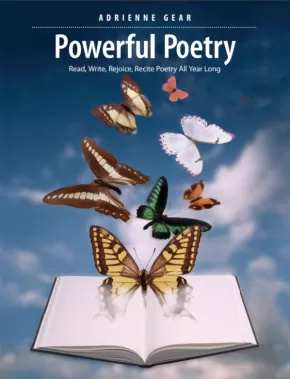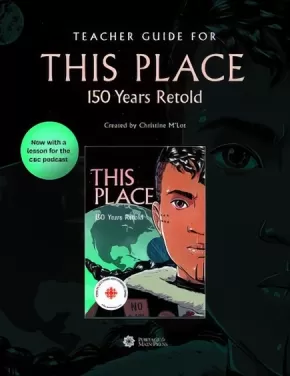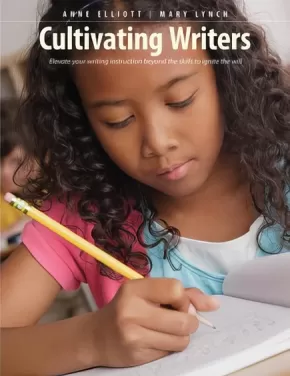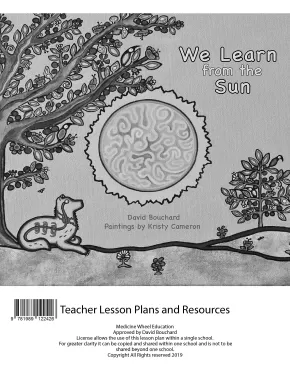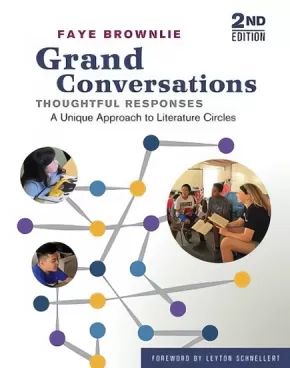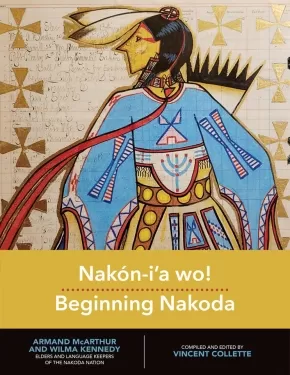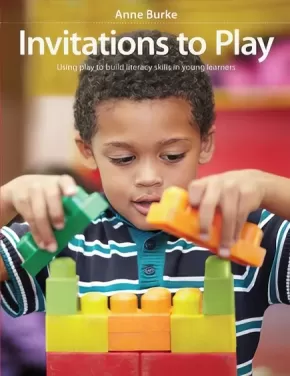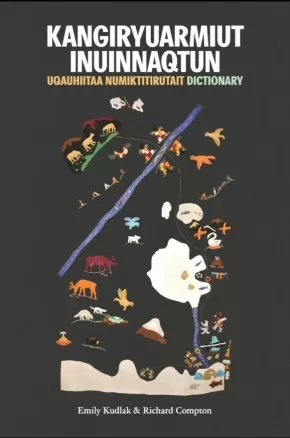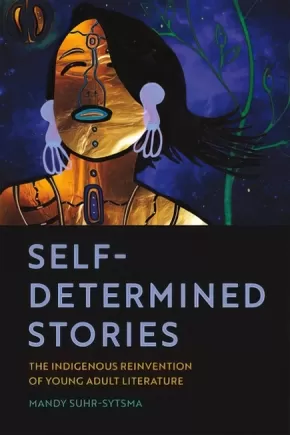
Literacy Resources
31
-
45
of
73 Results;
Sort By
Go To
of 5
Powerful Poetry: Read, Write, Rejoice, Recite Poetry All Year Long
$28.95
Format:
Paperback
ISBN / Barcode: 9781551383521
Synopsis:
Synopsis:
The power of poetry is at your fingertips with Adrienne Gear’s latest book!
Powerful Poetry celebrates the beauty, power and pleasure of poetry in the classroom. This highly readable book outlines the many benefits of integrating poetry into your literacy program, including building reading, writing and speaking skills, nurturing creativity and celebrating language. Powerful Poetry provides practical, enjoyable lessons for integrating poetry into your year-long literacy program and engaging ways to introduce poetic structure, language, tools and devices. Book lists introduce a wide range of wonderful poems and poets. Ideal for new and experienced teachers who are looking to bring the power of poetry into their classroom.
Additional Information
128 pages | 8.38" x 10.88" | Paperback
Sometimes Reading Is Hard: Using Decoding, Vocabulary, and Comprehension Strategies to Inspire Fluent, Passionate, Lifelong Readers
$28.95
Format:
Paperback
ISBN / Barcode: 9781551383514
Synopsis:
Synopsis:
When students say that reading is boring, difficult or overwhelming, or they cannot find a good book, it is almost impossible to sell them on the idea that reading is fun and worthwhile. Sometimes Reading is Hard shows teachers how to develop the skills students need to be successful and how to cultivate passionate, lifelong readers. Classroom vignettes, promising practices and step-by-step activities illustrate how teachers can weave teaching the skills of reading, decoding, vocabulary, comprehension and fluency with real reasons to read. When students want to read and they enjoy it, their reading skills improve. With the right motivation, any student can become an enthusiastic reader.
Educator Information
Provides evidence and examples of the relationship between developing skills and becoming successful, capable readers.
Describes how to weave decoding, vocabulary, comprehension and fluency with the reasons that students want to read.
Additional Information
160 pages | 8.38" x 10.88" | Paperback
Teacher Guide for This Place: 150 Years Retold - Revised (4 in Stock- In Reprint)
$28.99
Format:
Coil Bound
Text Content Territories:
Indigenous Canadian;
ISBN / Barcode: 9781774920176
Synopsis:
Synopsis:
The graphic novel, This Place: 150 Years Retold, includes a variety of historical and contemporary stories that highlight important moments in Indigenous and Canadian history.
Written by Anishinaabe educator Christine M'Lot, the Teacher Guide for This Place: 150 Years Retold offers 12 comprehensive lessons that support teachers in
- introducing students to the unique demographic, historical, and cultural legacy of Indigenous communities and exploring acts of sovereignty and resiliency
- using circle pedagogy to show the interconnectedness of ideas and topics, primarily in the form of the medicine wheel
- infusing Indigenous pedagogical practices, such as working with others, seeking holism in understanding, and learning through storytelling
- engaging students’ understanding and encouraging them to embrace differing worldviews
- NEW! Incorporating the This Place CBC podcast when studying the graphic novel
Educator Information
Lessons in this teacher guide are appropriate to Grades 9–12 English, Grade 11 Global Issues, and Grade 12 Current Topics in First Nations, Métis, and Inuit Studies classes. They are also adaptable to relevant university or college courses.
Additional Information
160 Pages | 8.5" x 11" | Spiral Bound
Cultivating Writers: Elevate Your Writing Instruction Beyond the Skills to Ignite the Will
$24.95
Format:
Paperback
ISBN / Barcode: 9781551383453
Synopsis:
Synopsis:
The six essential steps for nurturing writers who have the will to write is the core of this practical book. Based on extensive classroom experience, the book explores how teachers can help students tap into their own life experiences, model the habits of a writer and make use of the tools of the trade. Strategies throughout the book show teachers how to create an environment that helps students see writing as a rewarding experience in and outside the classroom. Powerful real-life anecdotes and ready-to-use activities support this guide to developing classrooms full of thoughtful, passionate writers.
Educator Information
Key Features:
-
Cultivating Writers is dedicated to fostering the WILL to write, unlike most other books that focus on skills.
-
This book is based on effective classroom experience with lots of anecdotes and student examples.
-
The authors show teachers how to encourage students to tap into their own life experiences.
-
Both authors have worked with school boards in developing literacy documents and present routinely at American state reading conferences.
Additional Information
160 pages | 8.38" x 10.88"
Powerful Writing Structures: Brain Pocket Strategies for Supporting a Year-Long Writing Program
$32.95
Format:
Paperback
ISBN / Barcode: 9781551383446
Synopsis:
Synopsis:
This timely book uses thinking structures to deepen student writing. It revolves around brain pockets to help students appreciate the qualities of different writing forms. Some powerful examples include memory pockets for personal narrative writing, fact pockets for nonfiction, and imagination pockets for story writing. Detailed lesson plans are featured along with sample anchor books and book lists. Based on extensive classroom testing, this unique approach to teaching writing is illustrated by student samples throughout the book. Suggestions for setting up an effective writing program and assessment tips for guiding instruction complete this comprehensive approach to developing a year-long writing program.
Educator Information
Powerful Writing Structures details how to set up an effective writing program that focuses on process rather than product.
Includes detailed lessons that focus on personal narrative, nonfiction and story writing.
Includes book lists of the best children’s books to anchor, support and extend lessons, student examples help illustrate how the strategies work in real classrooms.
Additional Information
160 pages | 8.38" x 10.88"
Teaching Tough Topics: How Do I Use Children's Literature to Build a Deeper Understanding of Social Justice, Equity, and Diversity?
$28.95
Format:
Paperback
Text Content Territories:
Indigenous;
ISBN / Barcode: 9781551383415
Synopsis:
Synopsis:
Teaching Tough Topics shows teachers how to lead students to become caring citizens as they read and respond to quality children’s literature. It focuses on topics that can be challenging or sensitive yet significant for building an understanding of social justice, diversity and equity. Racism, homophobia, bullying, religious intolerance, poverty, and physical and mental challenges are just some of the themes explored. The book is rooted in the belief that, by using picture books, novels, poetry, and nonfiction, teachers can enrich learning with compassion and empathy as students make connections to texts, to others and to the world.
Educator Information
Teaching Tough Topics is a timely approach to a better understanding of diversity, equity and social justice with clear instructions on how to implement a range of instructional strategies at different grade levels.
This book offers a valuable overview of tough topics including bullying, poverty, homophobia, gender, racism, death, Indigenous culture, physical and mental challenges, and religious intolerance.
Includes a comprehensive, up-to-date book list including picture books, novels, poetry and nonfiction titles that can be used to explore each topic.
Contains some Indigenous content.
Additional Information
144 pages | 8.38" x 10.88"
We Learn from the Sun: Lesson Plans and Resources
$7.99
Artists:
Format:
Paperback
Text Content Territories:
Indigenous Canadian; First Nations; Anishinaabeg;
ISBN / Barcode: 9781989122426
Synopsis:
Synopsis:
David Bouchard is a bestselling author, speaker and educator. He is Canada’s most sought after public speaker. We Learn from the Sun is an Indigenous rhyming poem based on his best selling book Seven Sacred Teachings.
This is a Teacher Lesson Plan and Resource Guild to accompany We Learn from the Sun, a richly illustrated book by Métis writer David Bouchard and Métis illustrator Kristy Cameron that weaves together Woodland style paintings with a rhythmic poem about the spiritual lessons that we can learn from the Sun and the seven sacred teachings.
Educator Information
This lesson plan and resource guide is approved by David Bouchard. License allows the use of this lesson plan within a single school.
The English lesson plans for We Learn From The Sun, includes:
– Fill in the Blanks Activity
– Word Search
– Colouring
– Write Your Own Poetry
– Matching Activity
Additional Information
15 pages | 8.50" x 11.00"
Freewriting with Purpose: Simple Classroom Techniques to Help Students Make Connections, Think Critically, and Construct Meaning
$32.95
Format:
Paperback
ISBN / Barcode: 9781551383392
Synopsis:
Synopsis:
Simple classroom techniques for to help students make connections, think critically, and construct meaning
In freewriting, we write continuously: we begin with a prompt and keep our pen or pencil moving throughout the entire duration. We do not stop to question or censor ourselves; we do not concern ourselves with spelling, punctuation, capitalization, or grammar; we do not let critical thoughts creep into our freewriting time. This book shows teachers how to use freewriting to help kids write well and more, regardless of grade level, subject, time of day, or time of year. It is not a difficult process to implement and yet it makes a significant difference in teacher attitudes, student confidence, and, ultimately, student writing abilities.
Educator Information
Recommended for educators of children ages 5 - 13.
Additional Information
144 pages | 8.30" x 10.80"
Grand Conversations, Thoughtful Responses: A Unique Approach to Literature Circles
$26.00
Format:
Paperback
Grade Levels: University/College;
ISBN / Barcode: 9781553798774
Synopsis:
Synopsis:
Grand Conversations, Thoughtful Responses is built upon the premise that all students can become active, independent, thoughtful readers. The structures and strategies in this book are proven to help students develop confidence and competence in their reading.
Student engagement with text soars through participation in grand conversations with peers and reflecting on reading with thoughtful, written responses. This unique approach includes:
- student choice in books
- students reading at their own pace, thus creating flexible groups
- literature circle groups where students discuss the shared text they are reading
- strategies for teaching written response
- strategies for co-creating assessment criteria
- additional activities to develop and deepen comprehension
- book lists
Reviews
"With this unique approach to literature circles, our students are reading more, are writing more and are excited about talking about their books! The enthusiasm in the class is contagious with even our more reluctant readers wanting more time – and more books - to read. It is a pleasure to join a group and participate in the conversation. Our students’ ability to make deep connections to one and other and to their reading is amazing." - Tanis Anderson, Literacy Programme Consultant, K-12 and a team of Burnaby teachers
Educator Information
Faye Brownlie is one of British Columbia's most sought-after literacy and learning experts. She works in staff development locally, nationally and internationally and has been a long-time advocate of improved learning for all students in inclusive settings.
What distinguishes this book’s approach is that it advocates students having a choice in what and how much they read, which in turn grows strong, thoughtful, sophisticated readers.
Additional Information
100 pages | 6.00" x 9.00" | 2nd Edition
Nakón-i'a wo! Beginning Nakoda
$34.95
Editors:
Format:
Coil Bound
Text Content Territories:
Indigenous Canadian; First Nations; Assiniboine (Nakoda Oyadebi);
ISBN / Barcode: 9780889776623
Synopsis:
Synopsis:
Nakón-i'a wo! Beginning Nakoda is a language resource designed to help revitalize and document Nakoda, now spoken in Manitoba and Saskatchewan.
Written for beginning learners of Nakoda (also known as Assiniboine), this workbook, arranged thematically, provides a Nakoda/English lexicon, a vocabulary, a table of kinship terms, a glossary of linguistic terminology, and exercises to do after each lesson.
This book was made possible with the assistance of Elders and Language Keepers of the Nakoda Nation: Armand McArthur and Wilma Kennedy, Main Consultants; with additional contributions by Pete Bigstone, Leona Kroscamp, Freda O'Watch, and Ken Armstrong.
Educator & Series Information
Recommended for Grades 7+
Part of the Indigenous Languages for Beginners series.
Additional Information
304 pages | 8.50" x 11.00" | Black and white illustrations throughout
Invitations to Play: Using Play to Build Literacy Skills in Young Learners
$28.95
Format:
Paperback
ISBN / Barcode: 9781551383361
Synopsis:
Synopsis:
Using play to build literacy skills in young learners
Our youngest learners thrive when their learning environment is one that celebrates curiosity, exploration, and imagination. This comprehensive resource sets the stage for play-based learning that will help children build a strong literacy foundation, as well as successfully negotiate the choices they make in real life.
A perfect blend of theory and instruction, Invitations to Play offers background and strategies for you to explore all aspects of playful learning. It shows you how to
- incorporate digital literacy — choose and use apps that will access children’s imaginary worlds and promote creative collaboration
- use music to develop sensory and collaborative learning — create music play centres that include making instruments from household items
- build on student home languages and ideas — guide children into English knowledge through social and collaborative interactions
- nurture multiple literacies — innovative ways to use play as scaffolding for later explorations in literacy
Invitations to Play gives new and experienced teachers a road map to involve and engage their young students in all forms of literacy learning.
Additional Information
160 pages | 8.40" x 10.80"
Kangiryuarmiut Inuinnaqtun: Uqauhiitaa Numiktitirutait Dictionary
$59.95
Format:
Paperback
Text Content Territories:
Indigenous Canadian; Inuit; Inuinnait (Copper); Kangiryuarmiut;
ISBN / Barcode: 9781897568552
Synopsis:
Synopsis:
The product of intensive, highly detailed work, this dictionary is more than a language document. It is a unique window into the Inuinnait culture and way of life.
Kangiryuarmiut Inuinnaqtun Uqauhiitaa Numiktitirutait - Kangiryuarmiut Inuinnaqtun Dictionary details the Kangiryuarmiut dialect of Inuinnaqtun, as spoken in the community of Ulukhaktok in the Inuvialuit Region of Canada's Northwest Territories. Very similar dialects of Inuinnaqtun are spoken in Qurluqtuq (Kugluktuk) and Iqaluktuuttiaq (Cambridge Bay) in Nunavut.
This is the most comprehensive dictionary of any Western Canadian dialect of the Inuit language. It contains over 5,000 Inuinnaqtun entries and subentries with their translations, over 3,000 example sentences, and a large inventory of suffixes.
The introduction includes a brief overview of Inuinnaqtun, its sound system, orthography, and major word classes. Main entries include both related subentries and examples. Suffix entries include information about lexical categories, inflection, the different forms a suffix may take, and examples of how each suffix is used.
Additional Information
582 pages | 6.50" x 9.50" | English, Inuinnaqtun
Literacy Essentials: Engagement, Excellence and Equity for All Learners (1 in Stock) - ON SALE
$30.00 $58.95
Format:
Paperback
ISBN / Barcode: 9781625310378
Synopsis:
Synopsis:
How do we ensure that all students are engaged each day in meaningful, challenging, and joyful work and have equal opportunity to learn?
That is the central question Regie Routman addresses in Literacy Essentials: Engagement, Excellence, and Equity for All Learners. Her response is that such an outcome is only possible within a culture of empowerment in which all students and teachers feel encouraged and supported to let their voices be heard, explore their passions and interests, develop deep knowledge, and become their fullest and truest selves.
Based on her ongoing teaching, leading, and coaching in diverse schools and districts, Regie offers K-12 teachers and leaders practical, easy-to-implement tools to help students develop as self-determining readers, writers, and learners including:
- Take Action sections with specific suggestions for authentically teaching, assessing, and learning
- Extensive research that is easily accessible and actionable
- Personal stories that connect to literacy teaching and learning
- Rich online resources including a comprehensive lesson plan, an easy-to-use study guide, downloadable Appendices, and more.
Literacy Essentials shows what’s possible when teachers and schools raise expectations for all students and create an intellectual culture based on trust, collaborative expertise, and celebration of learners’ strengths.
Educator Information
Audience Range: Ages 5-17
Additional Information
482 pages | 7.30" x 9.20"
Self-Determined Stories: The Indigenous Reinvention of Young Adult Literature
$29.95
Format:
Paperback
Text Content Territories:
Indigenous American; Indigenous Canadian;
Grade Levels: University/College;
ISBN / Barcode: 9781611862980
Synopsis:
Synopsis:
Reimagining Indigenous empowerment.
The first book of its kind, Self-Determined Stories: The Indigenous Reinvention of Young Adult Literature reads Indigenous-authored YA-from school stories to speculative fiction-not only as a vital challenge to stereotypes but also as a rich intellectual resource for theorizing Indigenous sovereignty in the contemporary era.
Building on scholarship from Indigenous studies, children’s literature, and cultural studies, Suhr-Sytsma delves deep into close readings of works by Sherman Alexie, Jeannette Armstrong, Joseph Bruchac, Drew Hayden Taylor, Susan Power, Cynthia Leitich Smith, and Melissa Tantaquidgeon Zobel. Together, Suhr-Sytsma contends, these works constitute a unique Indigenous YA genre. This genre radically revises typical YA conventions while offering a portrayal of Indigenous self-determination and a fresh critique of multiculturalism, heteropatriarchy, and hybridity. This literature, moreover, imagines compelling alternative ways to navigate cultural dynamism, intersectionality, and alliance-formation.
Self-Determined Stories invites readers from a range of contexts to engage with Indigenous YA and convincingly demonstrates the centrality of Indigenous stories, Indigenous knowledge, and Indigenous people to the flourishing of everyone in every place.
Contents
Introduction
Ch. 1: A Rebel with a Community, Not Just Cause: Revising YA Power Dynamics and Uniquely Representing Indigenous Sovereignty in Jeannette Armstrong's Slash
Ch. 2: Indigenous School Stories: Alternatives to Multiculturalism in Sherman Alexie's The Absolutely True Diary of a Part-Time Indian and Joseph Bruchac's The Heart of a Chief
Ch. 3: Not Your Father's Pocahontas: Cynthia Leitich Smith's and Susan Power's Resistive Romance
Ch. 4: That's One Story: Reworking Hybridity through Melissa Tantaquidgeon Zobel's and Drew Hayden Taylor's Speculative Fiction
Coda: Alexie's Flight, Zobel's Wabanaki Blues, and the Future of Indigenous YA Literature
Additional Information
214 pages | 6.00" x 9.00"
Teach Writing Well: How to Assess Writing, Invigorate Instruction, and Rethink Revision
$39.95
Format:
Paperback
ISBN / Barcode: 9781625311177
Synopsis:
Synopsis:
Ask successful writers and they’ll tell you, the key to writing well is revision. Ask elementary school teachers and they’ll tell you, the real challenge of writing instruction is teaching kids how to revise. Ruth Culham is both a successful writer and a writing teacher, and she’s discovered how to teach writing and revision in a way that’s accessible to both teacher and students: First read the writing, assess it using the traits of writing, then teach the writers and guide revision decisions using traits as a common language and map.
This book shows you how to assess and teach writing in a way that’s practical and doable—and best of all, see results. Traits-based revision lies at the heart of this book, as it’s been at the heart of Ruth’s career in writing instruction. Rethinking revision is what will ultimately help you to Teach Writing Well.
Educator Information
Part 1 walks you through the traits of writing and their key qualities, showing step by step how to read students’ writing and offer feedback that nudges them forward through the revision process. Chapters will help you address challenges students face within each mode of writing (narrative, expository, persuasive), and provide tools young writers can use to evaluate their own writing and make revision decisions accordingly.
Part 2 dives into instruction, offering specific guidance for how to use what you’ve learned from reading student writing to design lessons that scaffold students toward making their own craft decisions and revisions. In addition, there’s an entire chapter devoted to mentor texts that you can use to model traits and key qualities for your students.
Grade Range: 2-6
Additional Information
224 pages
Sort By
Go To
of 5

